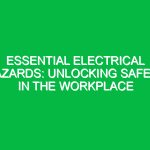Understanding Electricity Safety in the HSE Context
Electricity safety refers to the practices and precautions taken to prevent electrical hazards in the workplace. Within the Health, Safety, and Environment (HSE) domain, electricity safety is crucial—protecting employees from electrical shocks, fires, and other potential hazards. In a world increasingly reliant on electrical systems, understanding and implementing effective safety measures is not just a regulatory requirement; it is a fundamental aspect of a secure and productive work environment.
Many employees may overlook the risks associated with electricity, often considering it a mere utility. However, the statistics are alarming; according to the National Fire Protection Association, electrical malfunctions account for approximately 13% of all home fires. While workplaces might benefit from more stringent regulations and safety measures, the reality is that electrical hazards are still prevalent. By promoting a culture of electricity safety, organizations can significantly reduce the risk of incidents, ensuring a healthier and safer workplace.
The Importance of Electricity Safety in the Workplace
The implications of poor electricity safety can be severe. Beyond the immediate risk of injury or fatality, electrical issues can lead to costly downtime, property damage, and legal repercussions. For instance, a small electrical fire can escalate into a disaster, endangering lives and causing extensive property destruction.
Implementing robust electricity safety measures not only protects employees but also preserves company assets and ensures compliance with regulations. A workplace that prioritizes electricity safety fosters a culture of care and responsibility, enhancing employee morale and productivity.
Key Aspects of Electricity Safety
To maintain a safe working environment, it is essential to focus on several critical aspects of electricity safety:
1. Regular Inspections and Maintenance
Regular inspections of electrical systems are paramount. This includes checking wiring, outlets, circuit breakers, and appliances. A proactive approach helps identify potential hazards before they escalate. For example, frayed wiring is a common issue that can lead to shorts or fires. Schedule routine inspections with licensed electricians to ensure compliance with safety standards and to catch any potential issues early.
2. Proper Training and Awareness
Employee training is vital in promoting electricity safety. All employees should receive training on basic electrical safety principles, including how to identify hazards and respond to emergencies. This training should cover:
- Recognizing overloaded circuits.
- Understanding the importance of using equipment properly.
- Knowing how to safely use extension cords and power strips.
For instance, a manufacturing plant once faced a near-disaster when an employee used an extension cord rated for low power to operate a high-wattage machine, resulting in smoke and a fire. Fortunately, a vigilant colleague spotted the issue, but it underscored the need for comprehensive training.
3. Use of Personal Protective Equipment (PPE)
In environments where electrical work is performed, appropriate PPE is crucial. Hard hats, rubber gloves, and insulated tools should be available and properly used to safeguard workers against electrical shocks. Employees must be trained on the correct use of PPE and the importance of using it consistently.
4. Emergency Procedures
Every workplace should have established emergency procedures for electrical incidents. This includes:
- Clear instructions on how to shut down power in an emergency.
- Designated evacuation routes.
- Immediate reporting protocols for electrical hazards.
Regular drills should be conducted to ensure that everyone knows their roles in an emergency. For example, during a fire drill at a corporate office, employees practiced evacuating while shutting down electrical equipment, reinforcing the importance of both preparedness and safety.
5. Safe Equipment Usage
Employees must be educated on the proper use of electrical equipment. This includes avoiding the use of damaged equipment and following manufacturer guidelines. For instance, using equipment in wet conditions can pose serious risks. Workers should always check for warning labels and follow safety instructions.
Common Electrical Hazards in the Workplace
Understanding common electrical hazards is critical for preventing accidents:
- Overloaded Circuits: Plugging too many devices into one outlet can lead to overheating and fires.
- Damaged Insulation: Frayed cords and damaged plugs can expose employees to shocks.
- Wet Conditions: Water and electricity are a dangerous combination, increasing the risk of shocks.
- Inadequate Grounding: Equipment must be properly grounded to reduce shock risks.
Each hazard presents unique challenges and requires specific attention. For example, an office building that experienced a power outage due to overloaded circuits learned the hard way that proper load management is essential.
Regulations and Standards Governing Electricity Safety
Compliance with regulations is non-negotiable. In many countries, the Occupational Safety and Health Administration (OSHA) provides guidelines for electrical safety in the workplace. These standards are designed to protect employees from electrical hazards and to ensure that employers maintain safe working environments.
Key regulations include:
- OSHA Standard 29 CFR 1910.303: Covers electrical equipment standards.
- NFPA 70E: Provides guidelines for electrical safety in the workplace, emphasizing safe work practices.
- National Electrical Code (NEC): Sets the foundation for electrical installation safety.
Adhering to these standards not only ensures compliance but also enhances safety protocols, minimizing the risk of accidents.
Best Practices for Electricity Safety
To cultivate a culture of safety, organizations should adopt best practices such as:
- Document Safety Protocols: Create an electricity safety policy and ensure all employees have access to it.
- Implement a Safety Culture: Encourage employees to report hazards without fear of repercussions.
- Regular Training Sessions: Conduct ongoing training to keep safety knowledge current.
- Designate Safety Officers: Appoint individuals responsible for overseeing safety compliance.
These practices help embed electricity safety into the workplace culture, creating an environment where safety is prioritized.
Conclusion
Electricity safety is a vital component of maintaining a secure workplace within the HSE framework. By understanding the risks, implementing best practices, and adhering to regulations, organizations can protect their employees and assets.
As we have explored, electricity safety encompasses a wide range of activities—from regular inspections and employee training to emergency preparedness and equipment safety. Companies that prioritize these elements not only comply with legal standards but also foster a culture of care and responsibility that benefits everyone.
In today’s world, where electrical systems are indispensable, taking proactive steps to ensure electricity safety is not just beneficial; it is essential. Encourage your organization to embrace these principles and safeguard against the unseen dangers of electricity. The responsibility for a safe workplace lies with everyone—let’s work together to create an environment where safety is at the forefront.


